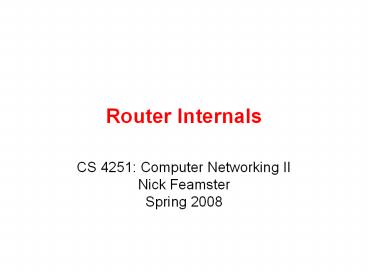Router Internals - PowerPoint PPT Presentation
Title:
Router Internals
Description:
Lookups and packet processing (classification, etc. ... Bipartite Match. Maximum. Weight Match. 21. Early Crossbar Scheduling Algorithm. Wavefront algorithm ... – PowerPoint PPT presentation
Number of Views:34
Avg rating:3.0/5.0
Title: Router Internals
1
Router Internals
- CS 4251 Computer Networking IINick
FeamsterSpring 2008
2
Todays Lecture
- The design of big, fast routers
- Design constraints
- Speed
- Size
- Power consumption
- Components
- Algorithms
- Lookups and packet processing (classification,
etc.) - Packet queueing
- Switch arbitration
3
Whats In A Router
- Interfaces
- Input/output of packets
- Switching fabric
- Moving packets from input to output
- Software
- Routing
- Packet processing
- Scheduling
- Etc.
4
What a Router Chassis Looks Like
Cisco CRS-1
Juniper M320
19
17
Capacity 1.2Tb/s Power 10.4kWWeight 0.5
TonCost 500k
Capacity 320 Gb/s Power 3.1kW
6ft
3ft
2ft
2ft
5
What a Router Line Card Looks Like
1-Port OC48 (2.5 Gb/s)(for Juniper M40)
4-Port 10 GigE(for Cisco CRS-1)
10in
2in
Power about 150 Watts
21in
6
Big, Fast Routers Why Bother?
- Faster link bandwidths
- Increasing demands
- Larger network size (hosts, routers, users)
7
Summary of Routing Functionality
- Router gets packet
- Looks at packet header for destination
- Looks up routing table for output interface
- Modifies header (ttl, IP header checksum)
- Passes packet to output interface
8
Generic Router Architecture
Header Processing
Lookup IP Address
Update Header
Queue Packet
Address Table
Buffer Memory
1M prefixes Off-chip DRAM
1M packets Off-chip DRAM
Question What is the difference between this
architecture and that in todays paper?
9
Innovation 1 Each Line Card Has the Routing
Tables
- Prevents central table from becoming a bottleneck
at high speeds - Complication Must update forwarding tables on
the fly. - How does the BBN router update tables without
slowing the forwarding engines?
10
Generic Router Architecture
Buffer Manager
Buffer Memory
Buffer Manager
Interconnection Fabric
Buffer Memory
Buffer Manager
Buffer Memory
11
First Generation Routers
Off-chip Buffer
Shared Bus
Line Interface
12
Second Generation Routers
CPU
Buffer Memory
Route Table
Line Card
Line Card
Line Card
Buffer Memory
Buffer Memory
Buffer Memory
Fwding Cache
Fwding Cache
MAC
MAC
MAC
Typically lt5Gb/s aggregate capacity
13
Third Generation Routers
Crossbar Switched Backplane
Line Card
CPU Card
Line Card
Local Buffer Memory
Local Buffer Memory
Line Interface
CPU
Routing Table
Memory
Fwding Table
MAC
MAC
Typically lt50Gb/s aggregate capacity
14
Innovation 2 Switched Backplane
- Every input port has a connection to every output
port - During each timeslot, each input connected to
zero or one outputs - Advantage Exploits parallelism
- Disadvantage Need scheduling algorithm
15
Other Goal Utilization
- 100 Throughput no packets experience
head-of-line blocking - Does the previous scheme achieve 100 throughput?
- What if the crossbar could have a speedup?
Key result Given a crossbar with 2x speedup, any
maximal matching can achieve 100 throughput.
16
Head-of-Line Blocking
Problem The packet at the front of the queue
experiences contention for the output queue,
blocking all packets behind it.
Output 1
Input 1
Output 2
Input 2
Output 3
Input 3
Maximum throughput in such a switch 2 sqrt(2)
17
Combined Input-Output Queueing
- Advantages
- Easy to build
- 100 can be achieved with limited speedup
- Disadvantages
- Harder to design algorithms
- Two congestion points
- Flow control at destination
input interfaces
output interfaces
Crossbar
18
Solution Virtual Output Queues
- Maintain N virtual queues at each input
- one per output
Input 1
Output 1
Output 2
Input 2
Output 3
Input 3
19
Router Components and Functions
- Route processor
- Routing
- Installing forwarding tables
- Management
- Line cards
- Packet processing and classification
- Packet forwarding
- Switched bus (Crossbar)
- Scheduling
20
Crossbar Switching
- Conceptually N inputs, N outputs
- Actually, inputs are also outputs
- In each timeslot, one-to-one mapping between
inputs and outputs. - Goal Maximal matching
Traffic Demands
Bipartite Match
L11(n)
Maximum Weight Match
LN1(n)
21
Early Crossbar Scheduling Algorithm
- Wavefront algorithm
Problems Fairness, speed,
22
Alternatives to the Wavefront Scheduler
- PIM Parallel Iterative Matching
- Request Each input sends requests to all outputs
for which it has packets - Grant Output selects an input at random and
grants - Accept Input selects from its received grants
- Problem Matching may not be maximal
- Solution Run several times
- Problem Matching may not be fair
- Solution Grant/accept in round robin instead of
random
23
Processing Fast Path vs. Slow Path
- Optimize for common case
- BBN router 85 instructions for fast-path code
- Fits entirely in L1 cache
- Non-common cases handled on slow path
- Route cache misses
- Errors (e.g., ICMP time exceeded)
- IP options
- Fragmented packets
- Mullticast packets
24
Recent Trends Programmability
- NetFPGA 4-port interface card, plugs into PCI
bus(Stanford) - Customizable forwarding
- Appearance of many virtual interfaces (with VLAN
tags) - Programmability with Network processors(Washingto
n U.)































